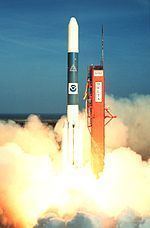Launch date 3 May 1986 | Bus HS-371 Launch site Cape Canaveral LC-17A Launch mass 660 kg | |
 | ||
Mission duration Failed to orbit7 years (planned) Manufacturer Boeing Satellite Development Center Similar GOES 5, GOES 7, GOES‑S, GOES 1, GOES 10 | ||
Delta goes g destructs over cape canaveral 5 3 86
GOES-G was a weather satellite to be operated by the National Oceanic and Atmospheric Administration. The satellite was designed to sense and monitor meteorological conditions from a geostationary orbit, intended to replace GOES-5 and provide continuous vertical profiles of atmospheric temperature and moisture. It was lost due to the launch failure of a Delta 3914 rocket on 3 May 1986.
Contents
Launch
Launch occurred on May 3, 1986 at 22:18 GMT, aboard Delta 178, the first NASA launch following the Challenger disaster. Seventy-one seconds into the flight, the first stage main engine shut down prematurely due to an electrical fault, and the rocket was destroyed by range safety.
Legacy
In 2015, director Ridley Scott used the explosion to depict the launch failure of the IRIS craft, in "The Martian".
